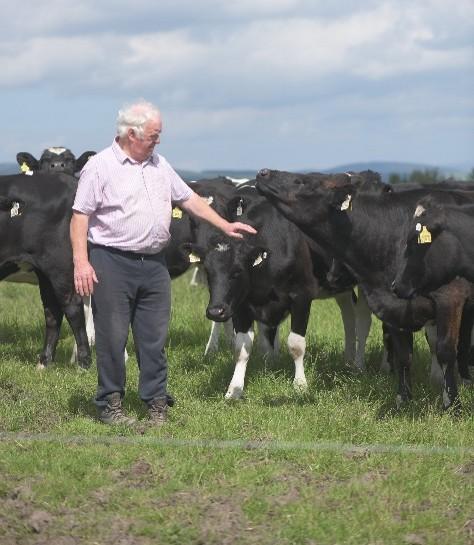James and Michael Kearney
James and Michael Kearney, Ballyduff, Co.Waterford
James Kearney and his son Michael are farming 45ha (plus co mmonage) in Ballysaggart, County Waterford. They have been rearing replacement heifers for dairy farmer, Adrian Casey for the last 6 years. Prior to this, the Kearney’s were running a friesian calf to beef system on the farm, purchasing their bull calves from Adrian. Adrian lost a block of leased ground that he was using to rear his replacement heifers and he subsequently made the decision to look for a contract rearer. The Kearneys were an obvious choice as he knew their set up and, was confident that the stock would be well managed. The Teagasc contract rearing template agreement was used during the initial discussions about the formation of the rearing arrangement. The agreement was drawn up for an initial three year period and covered all aspects of the arrangement from transport, dosing, vaccination, breeding, weight targets, conception rate targets and also what costs were to be borne by each party. They also agreed a maximum mortality rate and infertility rate and if levels were above this, a penalty system would be applied.
mmonage) in Ballysaggart, County Waterford. They have been rearing replacement heifers for dairy farmer, Adrian Casey for the last 6 years. Prior to this, the Kearney’s were running a friesian calf to beef system on the farm, purchasing their bull calves from Adrian. Adrian lost a block of leased ground that he was using to rear his replacement heifers and he subsequently made the decision to look for a contract rearer. The Kearneys were an obvious choice as he knew their set up and, was confident that the stock would be well managed. The Teagasc contract rearing template agreement was used during the initial discussions about the formation of the rearing arrangement. The agreement was drawn up for an initial three year period and covered all aspects of the arrangement from transport, dosing, vaccination, breeding, weight targets, conception rate targets and also what costs were to be borne by each party. They also agreed a maximum mortality rate and infertility rate and if levels were above this, a penalty system would be applied.
A written contract was put in place from the outset. Both parties agree that there is give and take and that there must be trust between them. Once they had agreed the terms of the contract, the price was the last topic to be discussed. The daily rearing fee is discussed at the beginning of the year and The Kearney’s are paid the agreed fee into their bank account on a monthly basis.
Each Spring, The Kearney’s collect approximately 80 calves from Adrian in batches. Calves are transferred from 14 days of age. Although Adrian only requires approximately 50 replacements per year for his 250 cow dairy herd, he is anxious that there are no other bovine stock on the Kearney’s farm so he ensures that he provides sufficient numbers to fully stock the farm. The Kearney’s will therefore buy a percentage of the calves that are transferred. Currently all the calves are Friesian heifers but if there were insufficient heifers born, it has been agreed that beef heifers from Adrian’s farm can also be used as an alternative. Following the breeding season, Arian will pick 50-55 of the early calving heifers and the remainder are The Kearney’s’ to sell at a date that they choose. Adrian’s in-calf heifers return home on a phased basis from October to December, at 21-23 months of age. Adrian covers the cost of transporting the heifer’s home, vaccines and breeding (synchronisation, AI and stock bulls to mop up) and The Kearney’s cover all other costs. Stock are weighed on a regular basis and this information is available for Adrian to view when he visits. They have agreed weight targets based on Teagasc guidelines and it is up to James and Michael to ensure that the heifers reach these targets. Adrian feels it is important that the feed costs are borne by the rearer as it encourages them to ensure stock meet their weight for age targets as economically as possible rather than the livestock owner paying higher feed costs if stock are behind target. The target weights for the various timescales are hanging above the crush where stock are weighed so it is easy for the Kearney’s to spot those that might be behind target so they can address this in a timely manner.
The agreement is working well for both parties. The Kearney’s have regular, repeat customers for the in-calf heifers that they sell and they appreciate that they are no longer at the mercy of a volatile beef market to make their income. Given that Adrian doesn’t have the replacements for the first winter, this has ensured that he is able to meet his slurry storage requirements for his remaining stock. This arrangement has also taken huge pressure off the dairy system at calving time, saving both time and labour – long may it last!
